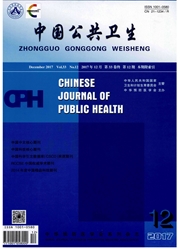

 中文摘要:
中文摘要:
目的探讨Toll样受体4(TLR4)在军团菌感染中作用。方法用C3H/HeJ小鼠、C3H/HeN小鼠作为实验动物,实验设C3H/HeJ、C3H/HeN染菌组及C3H/HeN对照组,染菌组气管注射军团菌悬液建立军团菌感染模型,对照组气管注射无菌生理盐水;观察主要脏器系数及肺组织病理改变,流式细胞术测定各组小鼠外周血单个核细胞(PBMC)中TLR4蛋白表达量变化。结果肺组织病理切片显示染菌组均有炎性细胞浸润并出现肺泡血管出血现象;与C3H/HeN对照组比较,染菌72hC3H/HeJ、C3H/HeN染菌组小鼠肺脏、脾脏脏器系数均升高,差异有统计学意义(P〈0.05);染菌12h时,C3H/HeJ染菌组小鼠PBMC中TLR4蛋白表达量为(48.31±5.22),低于C3H/HeN染菌组的(113.70±17.74)(P〈0.05),C3H/HeN染菌组与C3H/HeN对照组TLR4蛋白表达量差异无统计学意义(P〉0.05)。结论TLR4基因突变使小鼠对军团菌反应性降低,但TLR4对军团菌的抗感染作用机制仍需进一步研究。
 英文摘要:
英文摘要:
Objective To explore the relationship between Toll-like receptor 4 (TLR4) and Legionella infection in a mouse model. Methods TLR4 gene mutant mice of C3H/HeJ and control mouse C3I-I/HeN were used as experimental animals. The C3I-I/HeJ and C3H/HeN mice of infection group were treated with tracheal injection of bacterial suspension to make a mouse Legionella pneumophila infection model. The C3H/HeN mice in the control group were treated with tra- cheal injection of sterile saline. TLR4 protein expression level in peripheral blood mononuclear cells (PBMCs) of the mice were detected with flow cytometry. Results Pathological examination showed that lung tissue of C3H/HeJ and C3H/HeN infection group presented infiltration of inflammatory cells and alveolar vascular bleeding, while the mice of control group showed no inflammatory reaction. The lung and spleen coefficients of infection group were obviously higher than those in the control group. Legionella pneumonia model was established successfully. In 12 hours, TLR4 protein expression of C3H/HeJ infection group was relatively lower than that of C3I-I/HeN infection group ( P 〈 0. 001 ), but there was no significant difference in the expression between C3H/HeN infection group and C3H/HeN control group (P 〉 0. 05). Conclusion The TLR4 gene mutations could decrease the reaction to Legionella in mice. However, the anti-inflammatory effect of TLR4 on Leeionella needs further study.
 同期刊论文项目
同期刊论文项目
 同项目期刊论文
同项目期刊论文
 期刊信息
期刊信息
